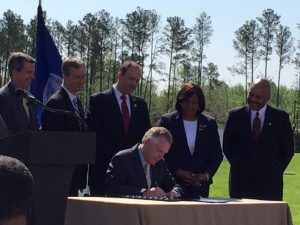Guest Blog: PACE is finally here in Virginia!
A guest blog post by Abby Johnson and Josh Doyon, Abacus Property Solutions
You may have heard by now about legislation passed in the 2015 Virginia General Assembly session (and signed into law by Governor McAuliffe) enabling an energy efficiency financing mechanism known as PACE, an acronym for Property Assessed Clean Energy. PACE is an innovative way for commercial property owners to finance energy efficiency and renewable energy improvements in their buildings. In a nutshell, where localities set-up PACE programs, loans provide 100% funding of total project costs by placing a special assessment lien on the property that the owner repays over time as part of his/her tax bill. These PACE loans are typically financed by capital providers who receive the PACE assessment payment via the local taxing authority.
signed into law by Governor McAuliffe) enabling an energy efficiency financing mechanism known as PACE, an acronym for Property Assessed Clean Energy. PACE is an innovative way for commercial property owners to finance energy efficiency and renewable energy improvements in their buildings. In a nutshell, where localities set-up PACE programs, loans provide 100% funding of total project costs by placing a special assessment lien on the property that the owner repays over time as part of his/her tax bill. These PACE loans are typically financed by capital providers who receive the PACE assessment payment via the local taxing authority.
PACE is unique to other kinds of equipment financing in a number of ways including:
- Longer loan terms of up to 20 years that are based on the equipment life (not lender preferences);
- Projects are cash flow positive – often from Year 1 – as the savings from the energy efficiency upgrades are greater than the annual PACE assessment;
- Loans are non-recourse, as they are property – not borrower – based; and
- As a form of “property tax,” the annual assessment does not become due at the time of sale but instead transfers automatically to the new owner.
From a macroeconomic standpoint, benefits include:
- Stimulation of jobs via increased construction activity, supporting a range of stakeholders such as contractors, product manufacturers, lending institutions, and energy engineers;
- Creation of significant numbers of high performance assets in markets, which attract better quality tenants, thereby raising real estate tax revenue while reducing functional obsolescence of the existing building stock.
PACE legislation is in some stage of development or adoption in more than thirty states and the District of Columbia, and is already thriving in California, Connecticut, Florida and Ohio. Success stories include the landmark Universal Studios Hilton hotel, which used PACE to finance the energy efficiency portion of a larger upgrade project totaling $12 million. The PACE loan – approximately $7 million – was used to replace aging chillers, install water efficient fixtures, install LED lighting and other measures for an estimated first year savings of $800,000. Another example is a project financed through the Toledo-Lucas Port Authority in Ohio to upgrade the One Maritime Plaza property. The Authority used $1.4 million in PACE financing to upgrade the cooling tower, interior lighting, and hot water pumps, reducing annual electricity usage by 48%.
Although it can be a powerful financing tool for larger, well capitalized assets, PACE provides probably the most value for the less comprehensive projects – too small to obtain competitive financing from larger banks or ESCOs and often unable to self-fund the upfront costs. Projects under $250k and even under $100k are coming online all the time for measures such as solar plus LED that provide a great return on investment.
PACE is soon to be implemented in Virginia, as the legislation will go into effect on July 1. Stakeholders in both the public and private sector will begin developing underwriting criteria catered to Virginia. A cohesive “PACE in a box” system that would provide the essential tools for localities to adopt PACE will soon be under development. The coming months will prove to be a busy time in the world of energy efficiency and renewable energy as Virginians will be able to realize the significant benefits that PACE can have on their buildings, portfolios, and communities.
